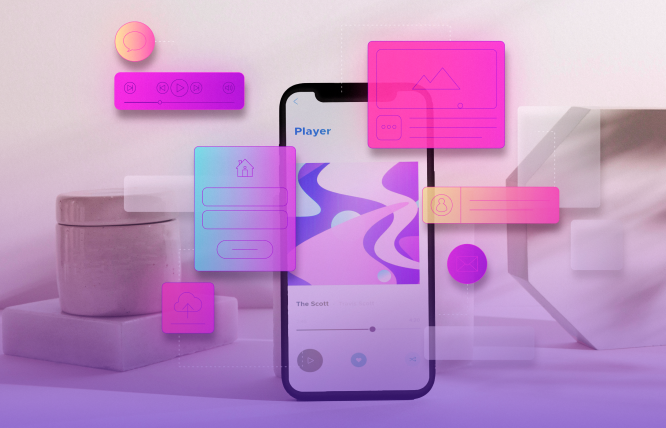This blog will break down all the details and use cases of PWA vs Native. Let’s check out the pros and cons and decide which of these best suits your project requirements.
While PWAs and native applications can be seen as different approaches to mobile application development, each of them has its advantages and limitations. Before deciding on which of the methods is suitable for your enterprise, it is critical to know what sets them apart.
StatCounter data reveals that as of 2023, mobile devices are being used for 56% of all internet usage, supporting increased use of mobile solutions such as PWAs and native applications.
According to a report by Comscore, people spend 87% of their time they spend on the internet on apps, mapping the importance of mobile interfaces for business organisations.
If you want an app that works well on any device, phone or computer. It loads lightning fast, remembers your data, and even lets you use it offline. Then go for the Progressive Web Apps (PWAs).
On the other hand, there are also classic native apps built specifically for iPhones or Android phones. So, how do you choose the right champion for your business?
Don’t worry; we’ll be your guide in this app arena. By the end of this blog, you’ll be a PWA vs native app whiz, ready to pick the perfect fit for your audience and goals.
Understanding PWAs and Native Apps
The term Progressive Web Apps (PWAs) refers to web applications that create an optimal mobile app-like experience. They are based on the technologies used for developing ordinary web platforms (HTML, CSS, JavaScript), but they use features that make them work like native applications. PWAs are always developed to be responsive; this means that it is usable on any device, be it a smartphone, a tablet, or a desktop.
On the other hand, a native app is built to work on a certain platform, whether iOS or Android, with the help of codings like Swift or Kotlin. They are downloaded directly from application stores and can make use of all the functions and components of the device, including camera, GPS, and notifications, providing a very efficient and personalised experience for the user.
Some points to take into consideration when choosing between PWAs and native apps include: PWAs are typically faster and less expensive to build compared to native apps in most cases. Since PWAs are primarily web applications, the developers can reuse the existing web development abilities and tools, which means minimal effort and less money.
Although the native applications generally take more effort & time, and money to build than the hybrid applications, they always provide better Performance & and more customisation on the targeted operating system. They can build applications that fully optimise the device’s hardware and operating system characteristics, thus providing the end-users with improved performance rates, smooth animation effects, and enhanced application usability.
PWA vs Native: A Breakdown
While PWA vs Native are different from each other, the usage might vary according to the audience’s needs.
In one corner, you have the native app, a powerhouse built specifically for a single platform (iOS or Android).
In the other corner, the PWA (Progressive Web App) stands tall, a versatile platform wielding the web’s reach. Both have their strengths and weaknesses, so let’s break them down to help you choose your winner.
Pros and Cons of Native Apps
| Pros | Cons |
Superior Performance | Higher Development Costs |
Access to Device Features (GPS, Camera) | Longer Development Time |
Enhanced User Experience | Platform-Specific |
Offline Functionality | Separate Codebases |
App Store Distribution | App Store Approval Process |
Pros and Cons of PWAs
| Pros | Cons |
Cross-platform Compatibility | Limited Access to Device Features |
No Installation Required | Dependency on Browser Capabilities |
Improved SEO | Limited Offline Functionality |
Lower Development Costs | Performance Limitations |
Easier Updates and Maintenance | Perception as Less “Native” than Native Apps |
Success Stories of PWAs and Native Apps
PWAs and native apps have both carved their own paths to success in the ever-evolving mobile landscape. Let’s look at some real-world examples to see how these technologies have empowered businesses and delighted users.
Examples of Successful PWAs
This innovative image-sharing site that went viral in a few days initially used web applications alone. They later switched to a PWA approach, which boosted their user engagement by 40% and session time by up by 60%. For apps that are mainly informative and based more on content, PWAs can be ideal as they are quick to load and easy to access.
Starbucks
The application created for the coffee giant also provides a delightful and swift way to order, especially when making impulsive purchases on the way to work. Owning to their web-based nature, PWAs are relatively cheaper ways through which a business entity can develop app-like experiences without necessarily going through the rigorous process of developing native applications. That being said, if you want an instant and budget-friendly approach to going mobile, a PWA development company can offer you custom PWA solution to your needs.
Pro Tip: Investing in search engine optimisation services with a PWA can be a successful strategy for businesses that aim to improve their online presence and reach a larger audience.
Examples of Successful Native Apps
This photo and video-sharing app leverages the native functionalities of smartphones, allowing for seamless photo editing and sharing. Native apps excel when deep device integration and powerful features are essential.
Uber
The ride-hailing app utilises GPS and location services to connect riders with drivers in real time. Native apps are ideal for situations where real-time functionality and constant location awareness are crucial.
Pro Tip: If you’re aiming to create a complex app with rich features and a highly customised user experience, consider partnering with a professional web development services company specialising in native app development. They can guide you through the process to create a top-notch app that stands out in the market.
Choosing Your Mobile App Champion: A Step-by-Step Guide
So, you’ve decided to dive into the exciting world of mobile apps! But with PWAs and native apps vying for your attention, picking the right solution can feel overwhelming. Fear not; here’s a simple roadmap to help you make the best choice for your needs.
Step 1: Identify Your Goals and Audience
Start by understanding your audience. Who are they? What devices do they use? Are they mostly on mobile or desktop? Knowing your users’ preferences can guide you in the right direction.
- Mobile Users: If your audience is primarily on mobile and expects a high-performance, feature-rich experience, a native app might be the best choice.
- Desktop and Mobile Users: If your audience uses both desktop and mobile devices, a PWA can provide a seamless experience across all platforms.
Step 2: Weigh the Pros and Cons
Now, let’s revisit our two contenders: PWAs and native apps. We explored their strengths and weaknesses earlier, but here’s a quick recap:
- PWAs: Shine with their cost-effectiveness, universal reach, and fast development. They’re perfect for content-driven apps or situations where a quick and easy mobile experience is key. However, PWAs might have limitations with offline functionality and access to certain device features.
- Native Apps: Dominate in terms of speed, deep device integration, and extensive offline capabilities. Ideal for apps requiring complex functionalities or real-time features like location tracking. The downside? Native apps can be pricier to develop and require separate versions for different platforms.
Step 3: Consider Development Resources
Budget and development expertise are important factors. While the costs are dependent on the timeline and features you might want in your application, here is a basic go-through:
PWAs are generally more cost-effective because they work across all devices with a single codebase. If you have a limited budget, a PWA could be a smart choice.
If you have a larger budget and need advanced features or deep integration with device hardware, investing in a native app could be worth it.
Step 4: Evaluate Performance Needs
Performance can make or break an app. If you require high performance, then go with Native apps that typically offer better Performance and faster load times, which are crucial for apps that require heavy processing or real-time updates.
PWAs can still provide a great user experience for less demanding applications, with the added benefit of offline functionality.
Step 5: Assess Development Time
If you need to launch your app asap with cross-platform functionality, then choose PWAs. It can be developed and deployed faster since they don’t require app store approvals and have a single codebase.
Native apps take longer to develop and get approved by app stores, but the investment can pay off in a more tailored user experience.
Step 6: Think About Future Maintenance
Maintenance and updates are ongoing parts of app ownership. PWAs are easier to maintain since updates are automatic and don’t require users to download new versions.
Native apps give you more control over updates, but they also require users to download the latest versions, which can be a hurdle.
Step 7: Get Professional Help
Seeking assistance from PWA experts can impact the success of your application.
Therefore, collaborate with a trustworthy PWA development firm such as FuturByte to guarantee that your PWA is developed with top-notch standards and optimised for efficiency.
Not just app development, you also need marketing to maximise your reach. Consider search engine optimization services or App Store optimisation services to increase the visibility of your app in search results, whether it’s a PWA or a native app.
Moreover, if your app needs to integrate with a website, look for custom website solutions to ensure a seamless experience. And that all can only be possible if you get professional web development services that can bring your vision to life.
Remember, there’s no one-size-fits-all answer. The best solution depends on your unique project. By following this roadmap and carefully considering your options, you’ll be well on your way to choosing the perfect mobile app solution for your needs.
Future Trends: Where is the Mobile App Market Heading?
The mobile app market is a living, breathing organism, constantly evolving and adapting to new technologies and user demands. As we peer into the crystal ball, here are some exciting trends that are poised to shape the future of mobile apps:
The Rise of Super Apps
Imagine an app that does it all – messaging, payments, shopping, food delivery, and more. That’s the concept behind super apps, popularised in countries like China. Expect to see a rise in these all-encompassing apps in the West, offering a one-stop shop for users and potentially changing how we interact with mobile services.
The Power of Foldables Takes Flight
Foldable phones are no longer a futuristic novelty. As these devices become more mainstream, app developers will need to adapt. We’ll likely see a surge in apps designed specifically for the unique functionalities of foldable screens, offering immersive and innovative user experiences.
AR and VR Go Beyond Gaming
Earlier the AR and VR have mostly been associated with the gaming world. But the future holds immense potential for these technologies beyond games. Imagine using AR for furniture shopping, where you can virtually place a couch in your living room to see how it looks. Or, picture VR training simulations for employees. The possibilities are endless!
AI Infiltrates the App Experience
Artificial intelligence (AI) is already making its way into many apps, personalising user experiences and automating tasks. Expect this trend to accelerate. AI-powered chatbots will become even more sophisticated, offering seamless customer support. Additionally, AI could personalise app recommendations and content, making your mobile experience even more tailored to your needs.
Security Concerns Take Center Stage
As mobile apps become more integrated with our lives, security concerns will continue to be a top priority. Expect to see app developers prioritise robust security features to protect user data and privacy.
The Future is Mobile (and Exciting!)
The mobile apps are constantly evolving and experiencing massive changes. Therefore, only by adopting new trends and creative solutions, app developers can meet the changing requirements of users.
Conclusion: Making Your Decision – PWA vs. Native App Showdown
We’ve had a solid PWA vs Native showdown – Now, it’s time to choose your champion!
- Make a note of what problem you are solving. Who is your target audience? Understanding your app’s purpose will guide your decision.
- PWAs shine with cost-effectiveness, while native apps excel in speed and deep device integration.
- Budget and development expertise play a role. PWAs generally require less investment than native apps.
Based on your needs, the PWA path might lead you to a cost-effective and widely accessible solution, while the native app path could be ideal for feature-rich experiences.
Final Thoughts: There’s No One-Size-Fits-All Answer
The decision as to which is the best PWA vs Native app depends on the specific project at hand. It is also important not to be afraid of getting a little creative here! In other cases, one may need a blend of PWAs and native applications to create a more seamless user experience.
Let me remind you that at the end of the project, you want a mobile app that will provide an extraordinary user experience. If you take into account all the suggestions outlined above, you will be ready to make the right decision and embark on a fabulous journey in the world of mobile applications!
Regardless of your choice, prioritise modern features, superfast responses, and regular updates to keep your app relevant and secure. Now, go forth and conquer the mobile app frontier!
Frequently Asked Questions
PWAs use a technology called service workers to cache data. This lets users access the app and its content even when they’re offline.
PWAs are generally cheaper to develop because you build one app that works on all devices. Native apps often require separate development for each platform (iOS and Android), which can be more expensive.
Yes, PWAs can be listed on app stores like the Google Play Store. However, listing on the Apple App Store is a bit more complicated, but possible with some extra steps.
It depends on your needs. PWAs are cost-effective and work across all devices. Native apps offer better performance and deeper integration with device hardware.
It’s unlikely that PWAs will completely replace native apps. Each has its strengths, and both will continue to coexist, serving different purposes.
Yes, we can develop both. We have a team of PWA and Native app development experts who can provide the best apps for all users.
Have questions or feedback?
Get in touch with us and we‘l get back to you and help as soon as we can!




